A Wi-Fi Union Mechanism for Internet Advertising Reciprocal Platform in Microenterprises
Abstract
:1. Introduction
2. Backgrounds
2.1. Internet Advertising and Mobile Advertising
2.2. Fog Computing
2.3. Related Work
3. Fog Computing Architecture-Based Wi-Fi Union Mechanism for Internet Advertising System
3.1. Wi-Fi Union Mechanism
3.2. System Architecture
- The Wi-Fi connection and the sending process of an advertisement to a union are directly controlled by an Internet advertising application on the smart devices of the Wi-Fi union members. In addition, an uploading function integrated in this application can be used to send advertisements to the union. Then, any member in the union could broadcast such an advertisement on their website or social network wall as a role of a publisher. When an advertisement is successfully promoted to consumers, the contribution point (CP) values of the publisher increase by one unit, while those of the advertiser decrease by one unit.
- When a consumer needs to use the free Wi-Fi of any enterprise, the Internet advertising application for the consumer version must be installed into their smart devices. When the consumer logs in, the website of the publisher can appear and the advertisement can be read by the consumer. Full information of the advertisement might be accessed by clicking on the advertisement icon or using scanning a QR Code.
3.2.1. Registration Process
3.2.2. Participation Process
3.2.3. Uploading Process
3.2.4. Downloading Process
3.2.5. Scanning Process
4. Evaluations
- I think that I would like to use this system frequently.
- I found the system unnecessarily complex.
- I thought the system was easy to use.
- I think that I would need the support of a technical person to be able to use this system.
- I found the various functions in this system were well integrated.
- I thought there was too much inconsistency in this system.
- I would imagine that most people would learn to use this system very quickly.
- I found the system very cumbersome to use.
- I felt very confident using the system.
- I needed to learn a lot of things before I could get going with this system.
5. Conclusions and Future Works
Acknowledgments
Author Contributions
Conflicts of Interest
References
- Sethuraman, R.; Tellis, G.J.; Briesch, R.A. How Well Does Advertising Work? Generalizations from Meta-Analysis of Brand Advertising Elasticities. J. Mark. Res. 2011, 48, 457–471. [Google Scholar] [CrossRef]
- France, K.R.; Bone, P.F.; France, J.W. Small Businesses and Comparison Advertising Strategies: Is it Worth the Risk? J. Small Bus. Strategy 2015, 7, 81–98. [Google Scholar]
- Romano, C.; Ratnatunga, J. The role of marketing. Eur. J. Mark. 1995, 29, 9–30. [Google Scholar] [CrossRef]
- Beck, T.; Lu, L.; Yang, R. Finance and Growth for Microenterprises: Evidence from Rural China. World Dev. 2015, 67, 38–56. [Google Scholar] [CrossRef]
- Quercia, D.; Di Lorenzo, G.; Calabrese, F.; Ratti, C. Mobile Phones and Outdoor Advertising: Measurable Advertising. IEEE Pervasive Comput. 2011, 10, 28–36. [Google Scholar] [CrossRef]
- Wilson, R.T.; Till, D.B. Effects of outdoor advertising: Does location matter? Psychol. Mark. 2011, 28, 909–933. [Google Scholar] [CrossRef]
- Belch, G.E.; Belch, A.M. A content analysis study of the use of celebrity endorsers in magazine advertising. Int. J. Advert. 2014, 32, 369–389. [Google Scholar] [CrossRef]
- McCoy, S.; Everard, A.; Polak, P.; Galletta, F.D. The effects of online advertising. Commun. ACM 2007, 50, 84–88. [Google Scholar] [CrossRef]
- Drèze, X.; Hussherr, F.-X. Internet advertising: Is anybody watching? J. Interact. Mark. 2003, 7, 8–23. [Google Scholar] [CrossRef]
- Li, Y.-M.; Lee, Y.-L.; Lien, N.-J. Online Social Advertising via Influential Endorsers. Int. J. Electron. Commer. 2012, 16, 119–154. [Google Scholar] [CrossRef]
- Goldfarb, A.; Tucker, C. Advertising Bans and the Substitutability of Online and Offline Advertising. J. Mark. Res. 2011, 48, 207–227. [Google Scholar] [CrossRef]
- Chu, S.-C. Viral Advertising in Social Media: Participation in Facebook Groups and Responses among College-Aged Users. J. Interact. Advert. 2011, 12, 30–43. [Google Scholar] [CrossRef]
- Mckenzie-Mohr, D. Promoting Sustainable Behavior: An Introduction to Community-Based Social Marketing. J. Soc. Issues 2000, 56, 543–554. [Google Scholar] [CrossRef]
- Yunos, M.H.; Gao, J.; Shim, S. Computer practices—Wireless advertising’s challenges and opportunities. Computer 2003, 36, 30–37. [Google Scholar] [CrossRef]
- Bergemann, D.; Bonatti, A. Targeting in Advertising Markets: Implications for Offline vs. Online Media Targeting in Advertising Markets: Implications for O-ine vs. Online Media. RAND J. Econ. 2011, 42, 417–433. [Google Scholar] [CrossRef]
- Selçuk, B.; Özlük, Ö. Optimal keyword bidding in search-based advertising with target exposure levels. Eur. J. Oper. Res. 2013, 226, 163–172. [Google Scholar] [CrossRef]
- Mitra, P. Targeted Advertising for Online Social Networks. In Proceedings of the 2009 First International Conference on Networked Digital Technologies, VSB Technical University, Ostrava, Czech Republic, 28–31 July 2009; pp. 366–372. [Google Scholar]
- Kim, K.Y.; Lee, G.B. Marketing insights for mobile advertising and consumer segmentation in the cloud era: A Q–R hybrid methodology and practices. Technol. Forecast. Soc. Chang. 2015, 91, 78–92. [Google Scholar] [CrossRef]
- PwC, IAB Internet Advertising Revenue Report—2012 Full Year Results, No. April 2015, 2013. Available online: http://www.pwc.com/ and https://www.iab.com/ (accessed on 11 July 2017).
- Ducange, P.; Pecori, R.; Mezzina, P. A glimpse on big data analytics in the framework of marketing strategies. Soft Comput. 2017, 21, 1–18. [Google Scholar] [CrossRef]
- López-nores, M.; Pazos-arias, J.J.; Blanco-fernández, Y.; Ramos-cabrer, M.; Gil-solla, A. Delivering Personalised m-Commerce Through Cloud-Based Augmented Reality on Billboards. In Proceedings of the 2015 IEEE International Conference on Consumer Electronics (ICCE), 9–12 January 2015; pp. 173–174. [Google Scholar]
- Aazam, M.; Huh, E.N. Resource Management in Media Cloud of Things. In Proceedings of the 2014 43rd International Conference on Parallel Processing Workshops, Minneapolis, MN, USA, 9–12 September 2014; pp. 361–367. [Google Scholar]
- Firdhous, M.; Ghazali, O.; Hassan, S. Fog Computing: Will it be the Future of Cloud Computing? In Proceedings of the Third International Conference on Informatics and Applications, Kuala Terengganu, Malaysia, 8–10 Octorber 2014; pp. 8–15. [Google Scholar]
- Aazam, M.; Huh, E.N. E-HAMC: Leveraging Fog computing for emergency alert service. In Proceedings of the 2015 IEEE International Conference on Pervasive Computing and Communication Workshops (PerCom Workshops), St. Louis, MO, USA, 23–27 March 2015; pp. 518–523. [Google Scholar]
- Stojmenovic, I.; Wen, S. The Fog Computing Paradigm: Scenarios and Security Issues. In Proceedings of the Federated Conference on Computer Science and Information Systems, Warsaw, Poland, 7–10 September 2014; pp. 1–8. [Google Scholar]
- You, W.; Learn, W. Fog Computing and the Internet of Things: Extend the Cloud to Where the Things Are, 2015. pp. 1–6. Available online: http://www.cisco.com/c/dam/en_us/solutions/trends/iot/docs/computing-overview.pdf (accessed on 11 July 2017).
- Stojmenovic, I. Fog computing: A cloud to the ground support for smart things and machine-to-machine networks. In Proceedings of the 2014 Australasian Telecommunication Networks and Applications Conference (ATNAC), Melbourne, Australia, 26–28 November 2014; pp. 117–122. [Google Scholar]
- Yi, S.; Hao, Z.; Qin, Z.; Li, Q. Fog Computing: Platform and Applications. In Proceedings of the 2015 Third IEEE Workshop on Hot Topics in Web Systems and Technologies (HotWeb), Washington, DC, USA, 12–13 November 2015; pp. 73–78. [Google Scholar]
- Korkut Altune, O.; Anil Konuk, F. Understanding Consumer Attitudes Toward Mobile Advertising and Its Impact on Consumers’ Behavioral Intentions: A Cross—Market Comparison of United States and Turkish Consumers. Communication 2009, 4, 43–52. [Google Scholar]
- Park, T.; Shenoy, R.; Salvendy, G. Effective advertising on mobile phones: A literature review and presentation of results from 53 case studies. Behav. Inf. Technol. 2008, 27, 355–373. [Google Scholar] [CrossRef]
- Chen, P.-T.; Hsieh, H.-P. Personalized mobile advertising: Its key attributes, trends, and social impact. Technol. Forecast. Soc. Chang. 2012, 79, 543–557. [Google Scholar] [CrossRef]
- Zhu, J.; Chan, D.S.; Prabhu, M.S.; Natarajan, P.; Hu, H.; Bonomi, F. Improving Web Sites Performance Using Edge Servers in Fog Computing Architecture. In Proceedings of the 2013 IEEE Seventh International Symposium on Service-Oriented System Engineering, Redwood City, CA, USA, 25–28 March 2013; pp. 320–323. [Google Scholar]
- Deng, R.; Lu, R.; Lai, C.; Luan, H.T.; Liang, H. Optimal Workload Allocation in Fog-Cloud Computing Towards Balanced Delay and Power Consumption. IEEE Internet Things J. 2016, 10, 1171–1181. [Google Scholar] [CrossRef]
- Yi, S.; Li, C.; Li, Q. A Survey of Fog Computing: Concepts, Applications and Issues. In Proceedings of the 2015 Workshop on Mobile Big Data, Hangzhou, China, 21 June 2015; pp. 37–42. [Google Scholar]
- Yannuzzi, M.; Milito, R.; Serral-Gracia, R.; Montero, D.; Nemirovsky, M. Key ingredients in an IoT recipe: Fog Computing, Cloud computing, and more Fog Computing. In Proceedings of the 2014 IEEE 19th International Workshop on Computer Aided Modeling and Design of Communication Links and Networks (CAMAD), Athens, Greece, 1–3 December 2014; pp. 325–329. [Google Scholar]
- Brooke, J. SUS -A Quick and Dirty Usability Scale. Usability and Context. Available online: http://www.usability.gov/ (accessed on 11 July 2017).
- Nguyen, T.-T.-A.; Hu, C.-M.; Yuan, S.-M. An Advertising Reciprocal Platform for Microenterprises. In Proceedings of the 2017 IEEE 31st International Conference on Advanced Information Networking and Applications (AINA), Taipei, Taiwan, 27–29 March 2017; pp. 79–84. [Google Scholar]
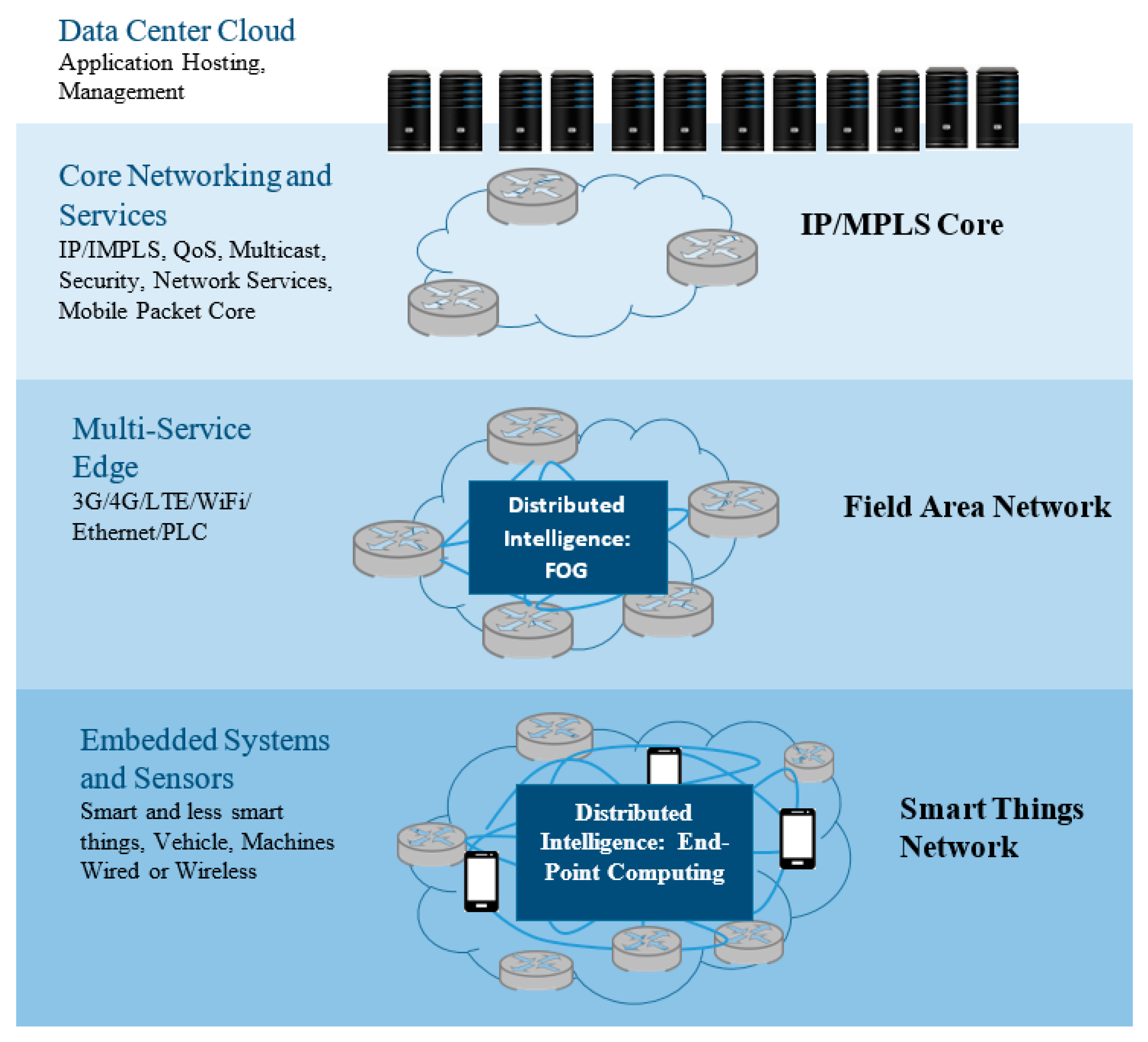
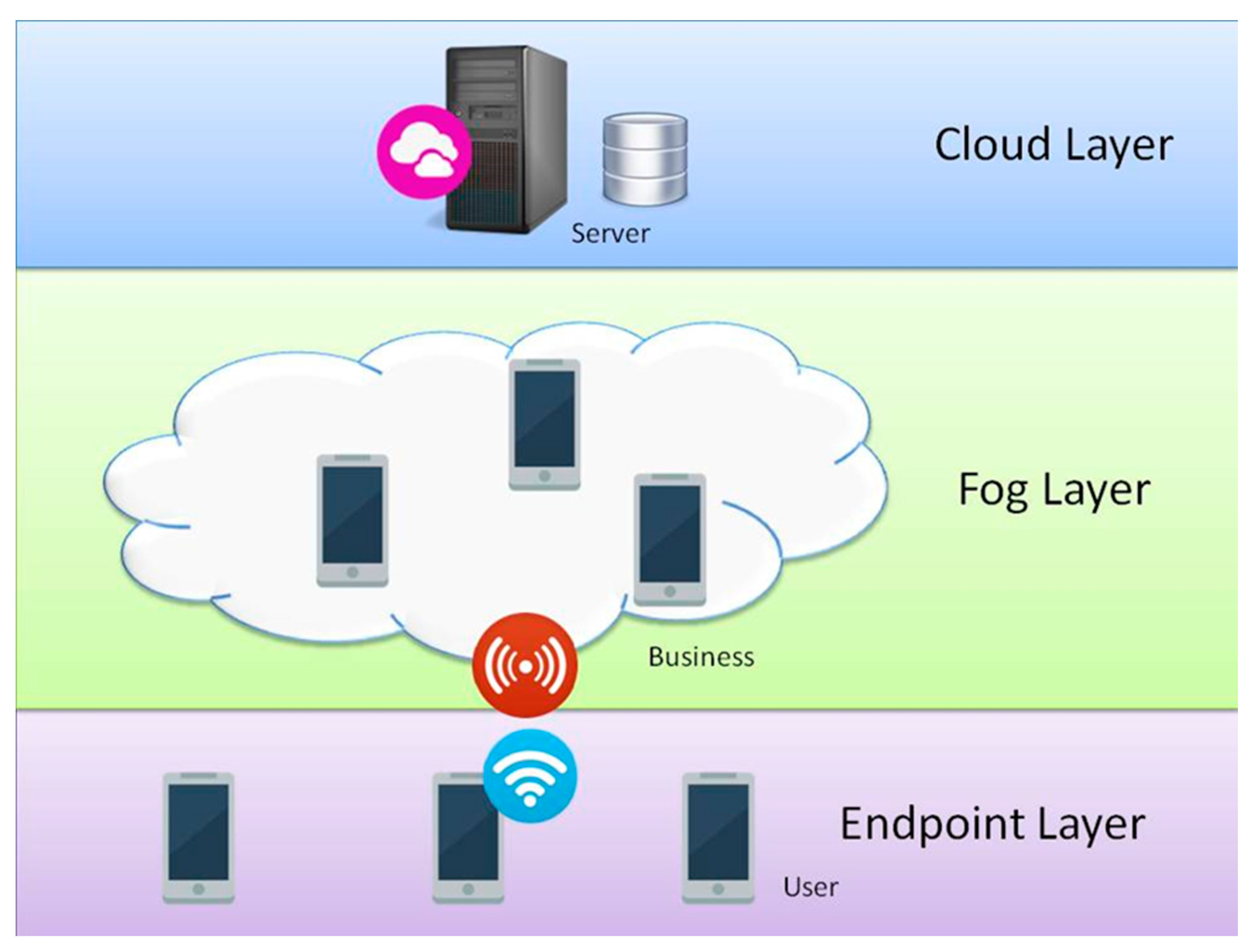

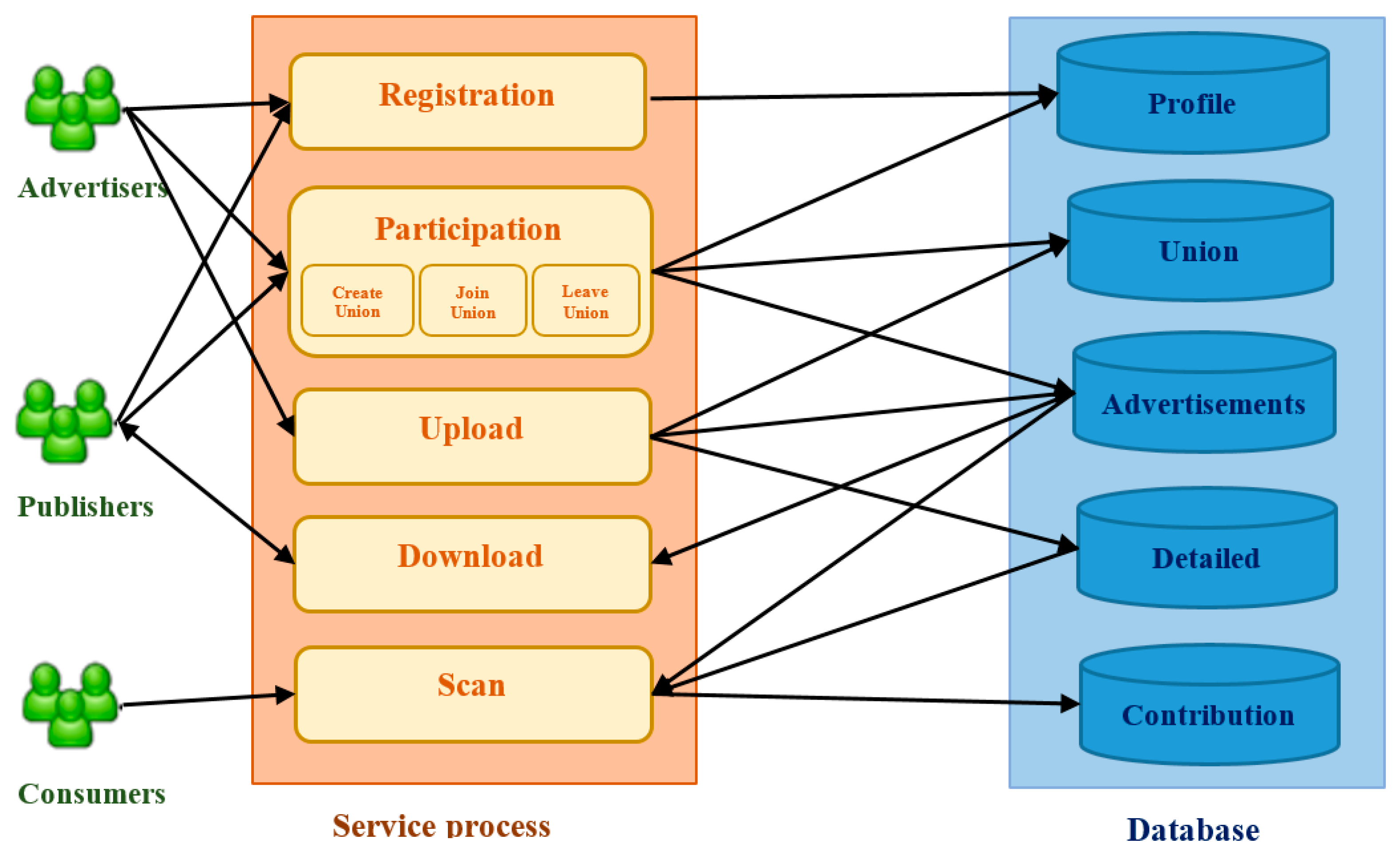
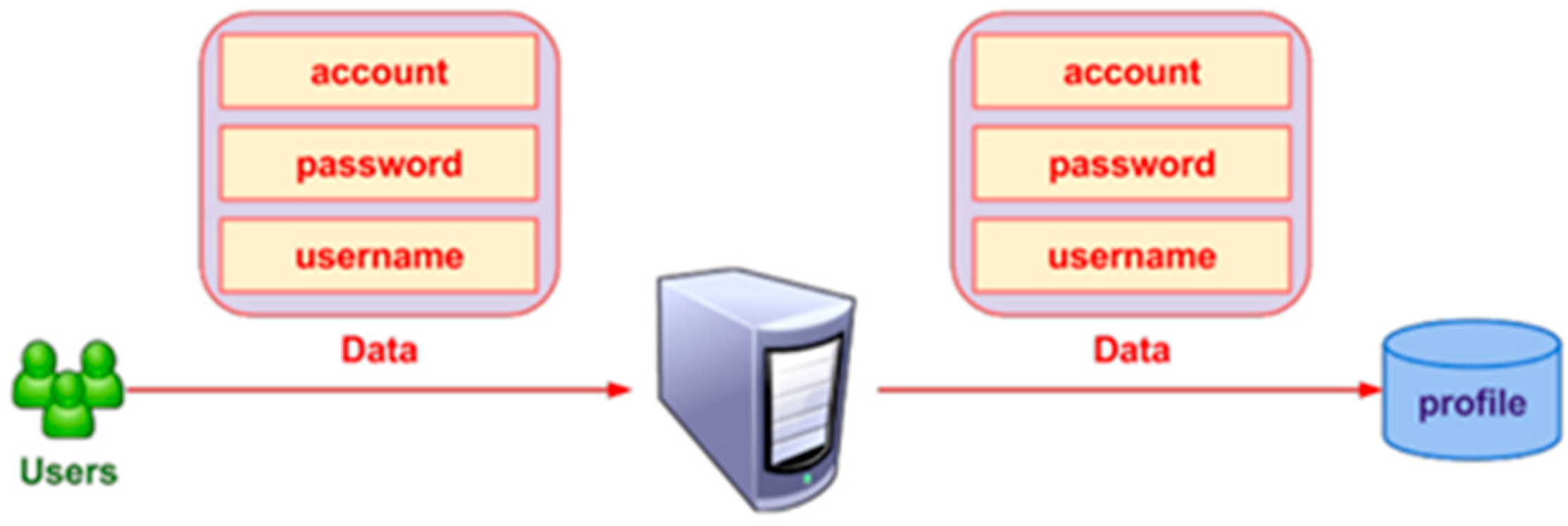
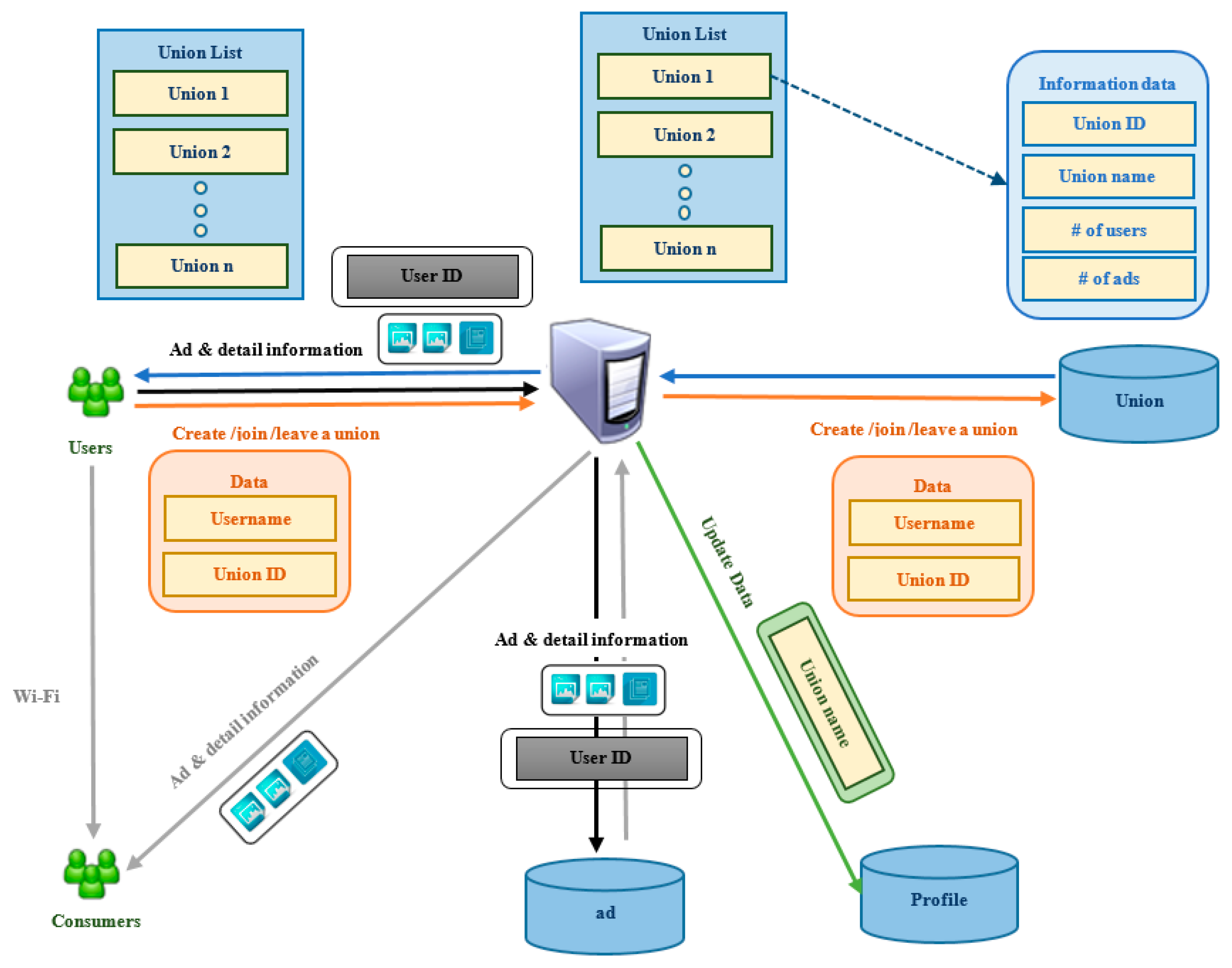


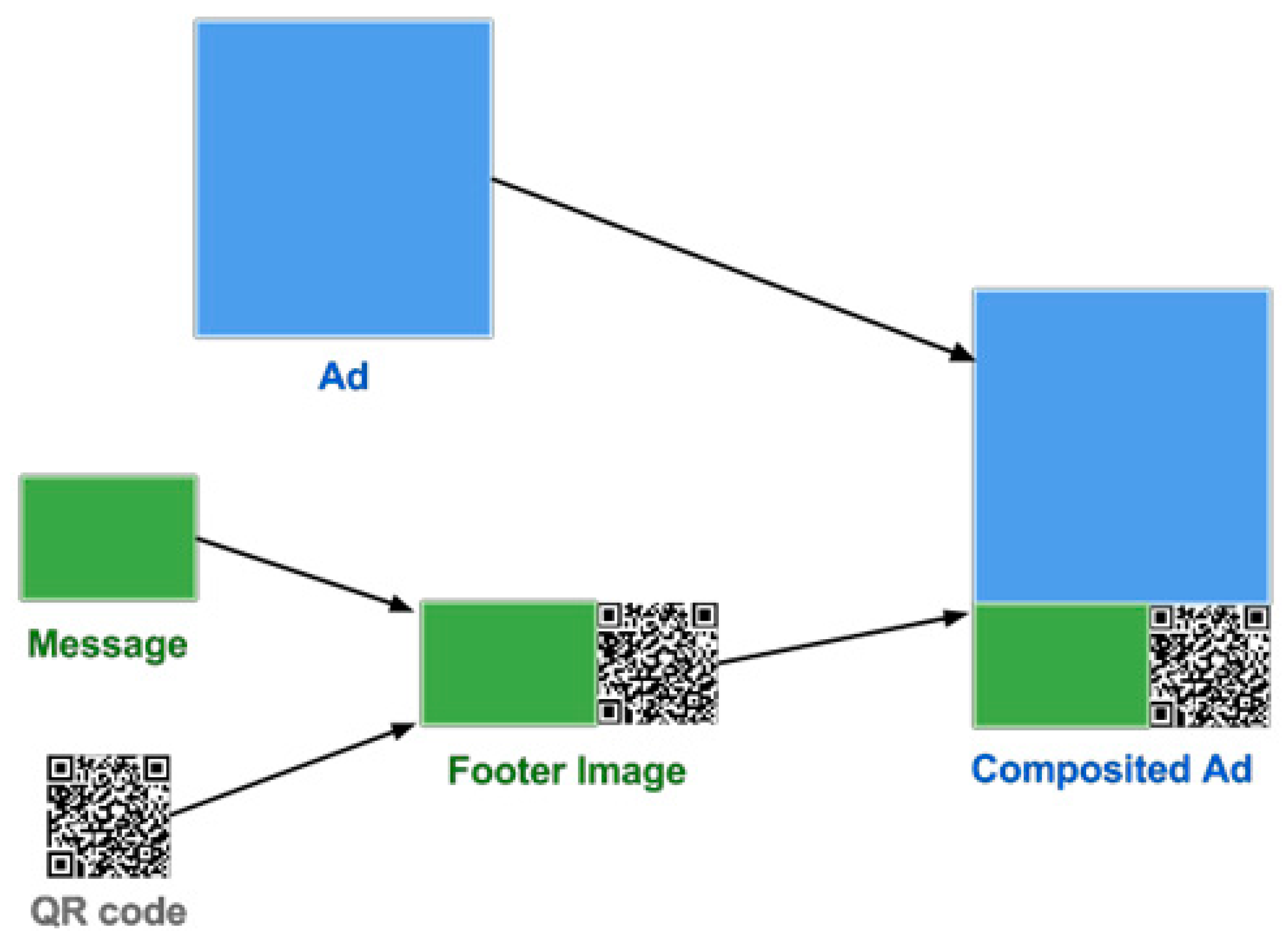
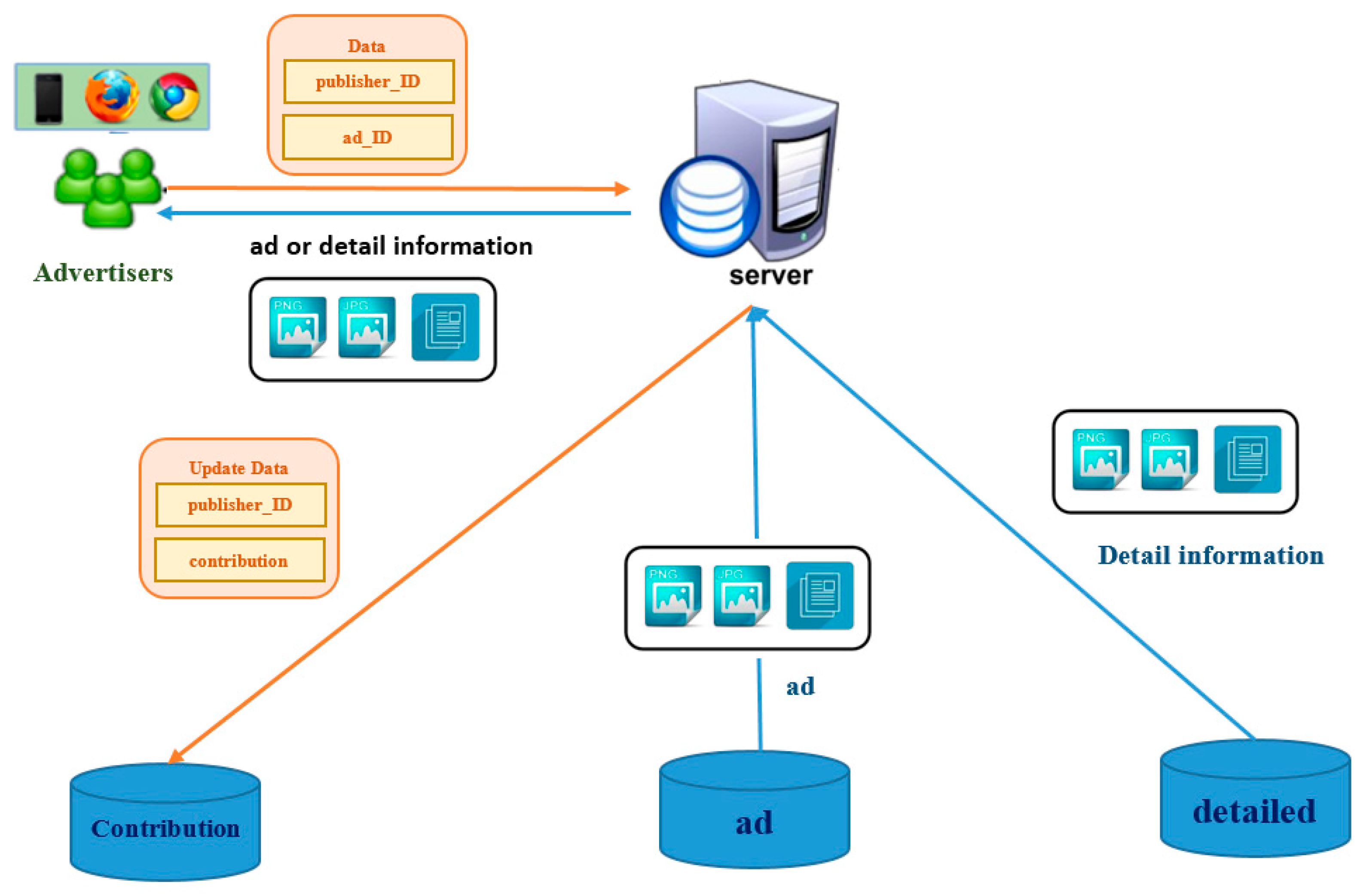
| Magazine/Newspaper | Television | Internet | Mobile | |
|---|---|---|---|---|
| Transmission mode | Visual/haptic | Audio/visual | Audio/visual | Audio/visual/haptic |
| Presentation type | Pull | Push | Pull | Pull and Push |
| Involvement | High | Low | Relatively high | High |
| Communication | One-way | One-way | Two-way | Two-way |
| Personalization | Medium | Difficult | Easy | Easy |
| Question Item | M1 | M5 | M10 | AVG (M) | C1 | C5 | C10 | AVG (C) |
|---|---|---|---|---|---|---|---|---|
| 1. I think that I would like to use this system frequently. | 4 | 4 | 4 | 3.1 | 3 | 4 | 3 | 3 |
| 2. I found the system unnecessarily complex. | 2 | 1 | 3 | 1.6 | 1 | 1 | 2 | 1.4 |
| 3. I thought the system was easy to use. | 4 | 3 | 4 | 3.6 | 4 | 4 | 3 | 3.5 |
| 4. I think that I would need the support of a technical person to be able to use this system. | 1 | 2 | 2 | 1.3 | 1 | 1 | 1 | 1.4 |
| 5. I found the various functions in this system were well integrated | 4 | 3 | 4 | 3.5 | 3 | 3 | 3 | 2.5 |
| 6. I thought there was too much inconsistency in this system | 3 | 2 | 2 | 2.8 | 3 | 2 | 3 | 2.3 |
| 7. I would imagine that most people would learn to use the system very quickly. | 4 | 3 | 4 | 3.8 | 4 | 4 | 4 | 3.9 |
| 8. I found the system very cumbersome to use. | 2 | 1 | 1 | 1.8 | 1 | 2 | 2 | 1.7 |
| 9. I felt very confident using this system. | 3 | 4 | 3 | 3.5 | 3 | 4 | 3 | 3.3 |
| 10. I needed to learn a lot of things before I could get going with this system. | 1 | 2 | 1 | 1.1 | 1 | 1 | 2 | 1.3 |
| SUS score | 72.5 | 72.5 | 65 | 72.5 | 77.5 | 80 | 67.5 | 70.25 |
© 2017 by the authors. Licensee MDPI, Basel, Switzerland. This article is an open access article distributed under the terms and conditions of the Creative Commons Attribution (CC BY) license (http://creativecommons.org/licenses/by/4.0/).
Share and Cite
Nguyen, T.T.A.; Chang, C.-P.; Yuan, S.-M. A Wi-Fi Union Mechanism for Internet Advertising Reciprocal Platform in Microenterprises. Sensors 2017, 17, 1617. https://doi.org/10.3390/s17071617
Nguyen TTA, Chang C-P, Yuan S-M. A Wi-Fi Union Mechanism for Internet Advertising Reciprocal Platform in Microenterprises. Sensors. 2017; 17(7):1617. https://doi.org/10.3390/s17071617
Chicago/Turabian StyleNguyen, Thi Thanh An, Che-Pin Chang, and Shyan-Ming Yuan. 2017. "A Wi-Fi Union Mechanism for Internet Advertising Reciprocal Platform in Microenterprises" Sensors 17, no. 7: 1617. https://doi.org/10.3390/s17071617
APA StyleNguyen, T. T. A., Chang, C.-P., & Yuan, S.-M. (2017). A Wi-Fi Union Mechanism for Internet Advertising Reciprocal Platform in Microenterprises. Sensors, 17(7), 1617. https://doi.org/10.3390/s17071617






